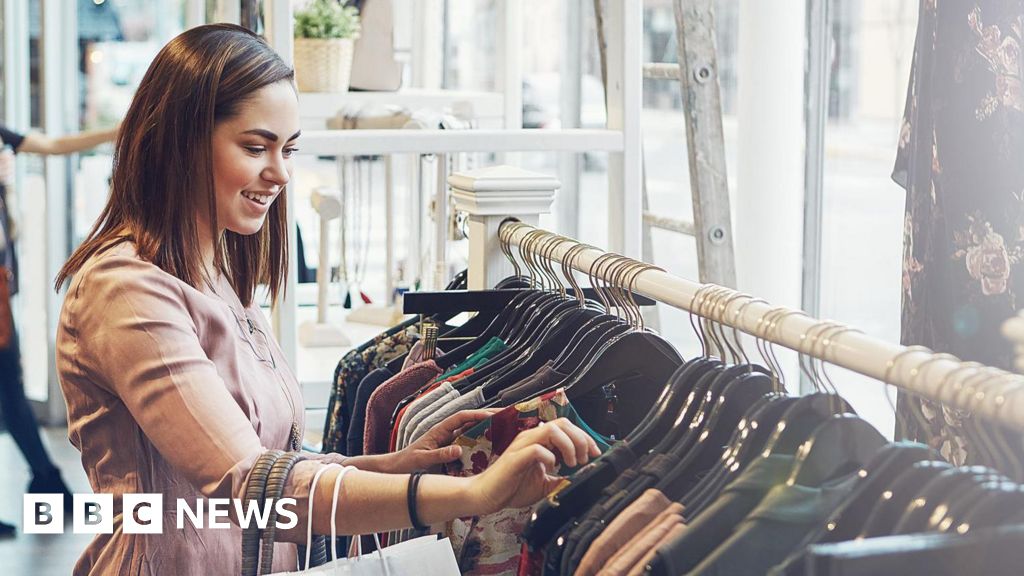Retail sales rose for the third month in a row in March as warmer weather helped boost demand for items such as clothing and DIY goods. Sales volumes climbed 0.4% last month, the Office for National Statistics said, with the sunshine helping a variety of sectors. However, the ONS said it was another poor month for food sales, particularly at supermarkets. Analysts also warned that the recent run of sales increases might be about to come to an end after a separate survey suggested consumer confidence fell in April. The latest retail sales figures were stronger than expected, with analysts having predicted a 0.4% fall in March. The increase last month means that across the January to March quarter, sales volumes were up 1.6% compared with the previous quarter, which the ONS said was the biggest increase for nearly four years. The sunny weather in March helped sales at garden centres, which reported "robust trading", the ONS said. Sales at non-food stores rose by 1.7% over the month, but this was partly offset by food store sales volumes falling 1.3%. However, a survey from market research firm GfK suggested consumer confidence in April fell to its lowest level since November 2023, as people faced rising bills and became more pessimistic about the prospects for the economy. "Consumers have not only been grappling with multiple April cost increases in the form of utilities, council tax, stamp duty, and road tax, but they are also hearing dire warnings of renewed high inflation on the back of the Trump tariffs," said Neil Bellamy, consumer insights director at GfK.
Clothing and DIY sales boosted by sunny weather
TruthLens AI Suggested Headline:
"UK Retail Sales Increase Driven by Warmer Weather, but Consumer Confidence Declines"
TruthLens AI Summary
In March, retail sales in the UK experienced a notable increase for the third consecutive month, largely attributed to the warmer weather that spurred demand for clothing and DIY products. According to the Office for National Statistics (ONS), sales volumes rose by 0.4% in March, surpassing analysts' expectations who had forecasted a decline of 0.4%. This growth contributed to a 1.6% increase in sales volumes over the first quarter of the year, marking the most significant rise in nearly four years. The pleasant weather particularly benefited garden centers, which reported strong trading, while non-food stores saw an overall sales increase of 1.7%. However, this positive trend was overshadowed by a decline in food sales, particularly at supermarkets, which saw a drop of 1.3% in sales volumes during the same period.
Despite the encouraging retail sales figures, concerns about consumer confidence loom large as a separate survey by GfK indicated a decline in consumer sentiment in April, reaching its lowest point since November 2023. Rising living costs, including increased bills and taxes, have contributed to this pessimism among consumers. Neil Bellamy, the consumer insights director at GfK, pointed out that consumers are grappling with multiple cost increases, including utilities and council tax, alongside warnings of renewed inflation due to external economic factors. This combination of rising expenses and economic uncertainty raises questions about the sustainability of the recent retail sales growth, suggesting that the upward trend may soon face challenges as consumer confidence falters.
TruthLens AI Analysis
The article highlights the impact of warmer weather on retail sales, particularly in clothing and DIY goods. It notes a positive trend in sales volume, marking the third consecutive month of growth. However, it also points out a significant decline in food sales, especially in supermarkets, indicating a mixed economic scenario. Analysts caution that despite the recent sales increases, consumer confidence may be waning, driven by rising costs and economic uncertainty.
Economic Implications
The report serves to illustrate the resilience of certain retail sectors in response to seasonal changes, potentially creating a sense of optimism about economic recovery. However, the contrasting performance of food sales introduces a note of caution, suggesting that not all sectors are benefiting equally from the changing weather. The mention of declining consumer confidence is particularly noteworthy as it raises concerns about the sustainability of the positive sales trend.
Consumer Sentiment
There is an underlying narrative concerning consumer behavior and sentiment. While the immediate data shows growth in non-food retail, the larger context suggests that consumers are feeling the pinch from increasing living costs. The article provides a snapshot of a potentially fragile economic situation, where short-term sales boosts may not translate to long-term confidence.
Manipulative Aspects
The article could be perceived as having a manipulative angle, as it emphasizes sunny weather’s positive effects on sales while downplaying the negative implications of falling consumer confidence. By highlighting the growth figures prominently, it may lead readers to adopt a more optimistic view of the retail landscape without fully considering the broader economic challenges.
Connection with Broader Trends
When compared with other reports focusing on economic indicators, this article fits into a larger narrative about the post-pandemic recovery phase. It suggests a dual reality in the economy, where some sectors thrive while others struggle, reflecting ongoing disparities in consumer experiences.
Market Impact
This information could influence stock market perceptions, particularly for companies in the retail sector. Positive sales data for clothing and DIY goods might bolster investor confidence in those segments, while the decline in food sales could raise red flags for supermarket stocks.
Societal Influence
The article may resonate more with demographics inclined towards outdoor activities or home improvement, as these groups are likely to benefit from the reported trends. Conversely, those struggling with rising living costs might feel marginalized by the focus on retail growth.
In conclusion, the article presents a mixed bag of information that reflects a complex economic landscape. While it highlights positive retail trends, the warnings about falling consumer confidence and rising costs suggest that the overall picture may not be as rosy as it appears. The reliability of the article hinges on its balanced presentation of both the benefits and challenges facing different market segments.
